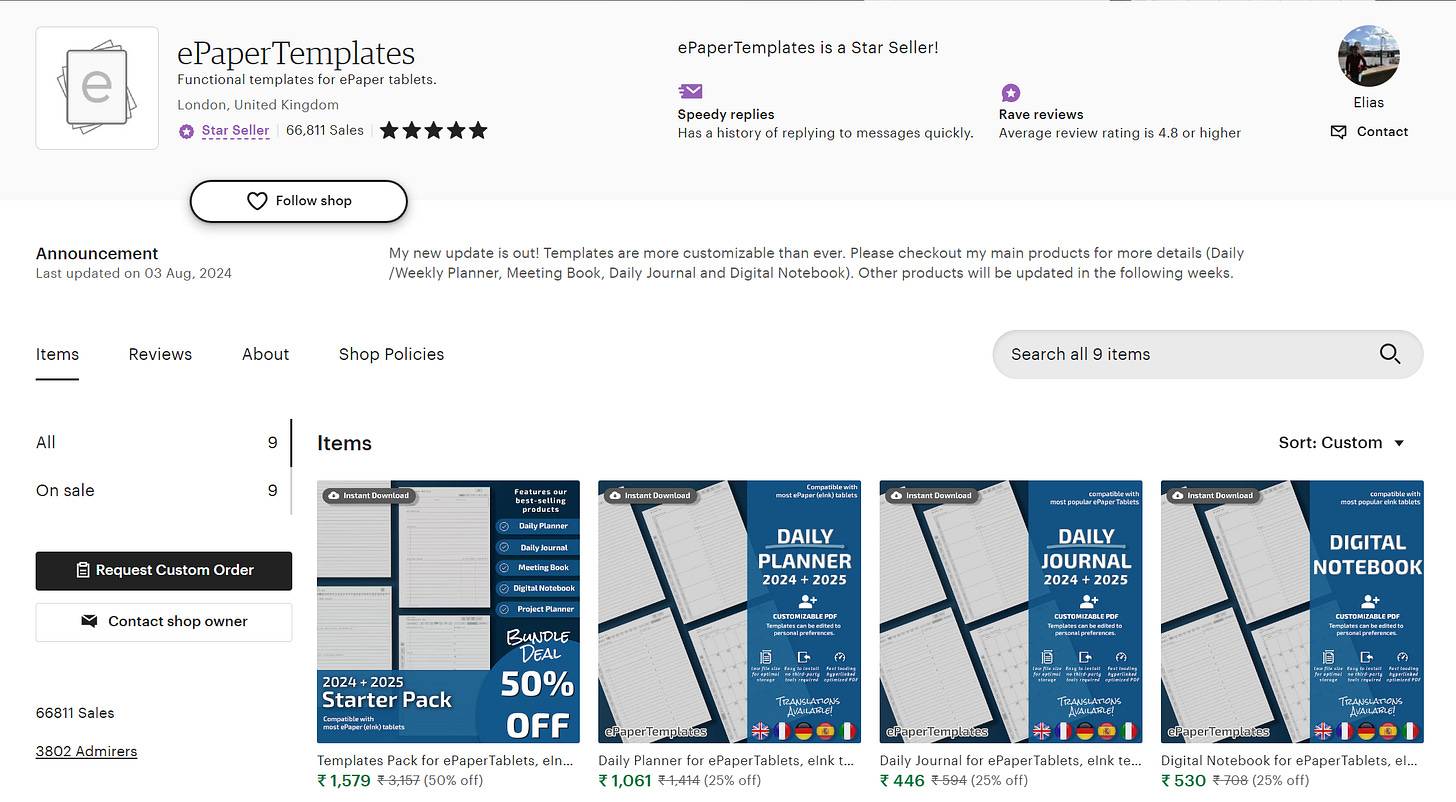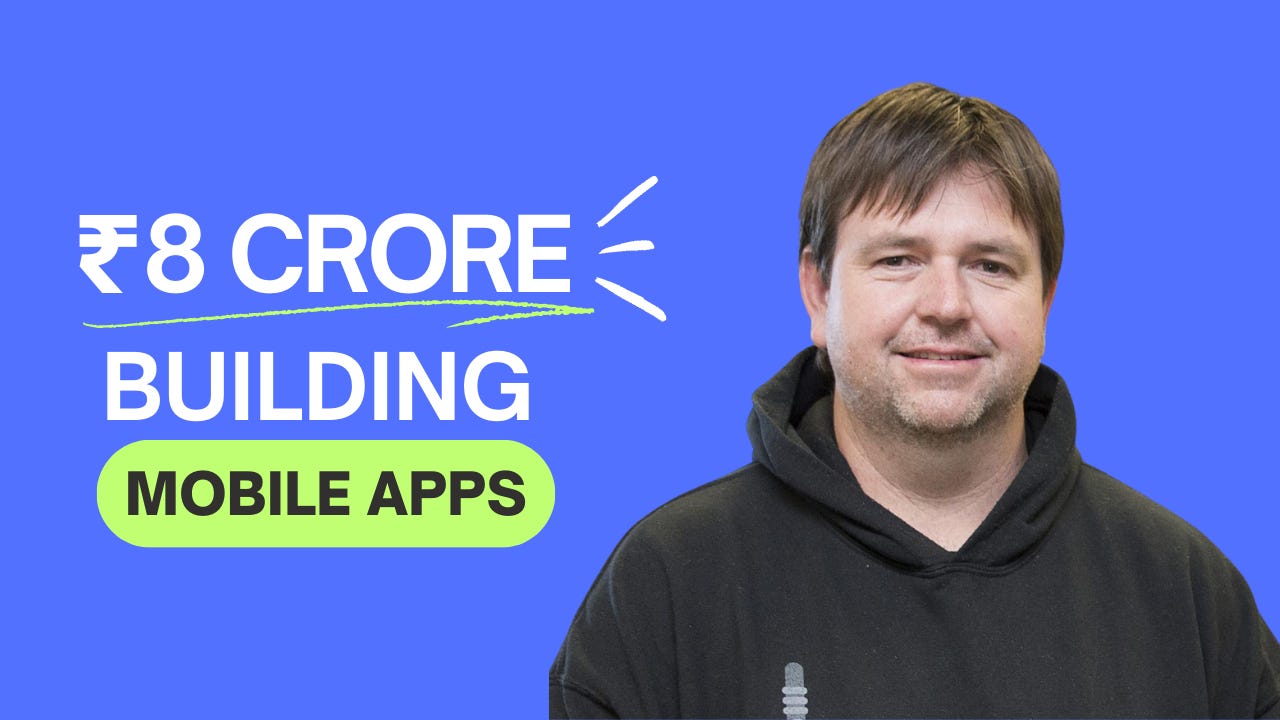$500,000 Selling ePaper Templates on Etsy
Hello Tribe,
Welcome to another exciting edition of MoneyMint! We're more than just a newsletter—we're a community of go-getters, dreamers, and doers.
Every week, we're here to empower you with the tools, tips, and inspiration you need to turn your financial goals into reality.
₹4.2 Crore ($500K) Selling ePaper Templates on Etsy
Imagine making $500k selling digital journals. Sounds too good to be true, right?
Well, that's exactly what ePaperTemplates does on Etsy. It sells "functional templates for ePaper tablets."
They sell digital templates like daily planners, to-do lists, etc. for devices like reMarkable, Amazon Kindle Scribe, Supernote, etc.
According to a recent profile by Capital Friday, this shop, which started in 2020, has been raking in profits.
They have sold 66,000 units at an average price of $9 USD, resulting in an impressive revenue of around $594k till now. On an average they make $190,000 per year from selling these digital templates.
The best part? Once you create the digital files, your costs are minimal. Each sale is almost pure profit.
Here's the kicker: these journals are relatively simple to create. With some design skills and market research, you can tap into this lucrative niche. A quick search on YouTube can teach you how to build these templates yourself.
What about competition? There are hundreds of other digital planners out there, but they're all doing well and making good money.
Here is another store called Plannerscollective doing $1.1 million since its launch.
The key is not to worry about outcompeting everyone, but rather to focus on creating value for a specific audience. With the right approach, you could join the ranks of these successful digital planner sellers.
$1.2 million: Building Mobile Apps as Side Projects
Ever thought about creating a mobile app on the side? It can be an exciting way to learn new skills, bring your ideas to life, and even make some extra cash! 🚀
Meet Stuart Hall, co-founder and co-CEO of Appbot. Stuart is a big believer in side projects throughout his career. Personally, Stuart has managed to get millions of downloads and over a million USD in revenue from his side projects!
According to recent reddit post by Stuart, he has made over $1.2 million dollars with just 2 apps:
Here is a revenue graph shared by Stuart:
Why start a side project?
Why choose a mobile app for your side project:
Nearly everyone owns a smartphone, giving your app a wide potential audience.
App stores handle distribution and can even help with marketing.
Built-in payment tools simplify monetization and maintenance.
With the right idea, you might not even need a server!
7 Minute Workout was born as an experiment. Stuart wanted to see if he could build an app, iterate on it, and build a story around it. The app exceeded expectations, it ended up getting millions of downloads and even getting acquired.
It also generated content that reached hundreds of thousands of people and helped propel Stuart's other venture, Appbot, in its early days.
WordBoard, on the other hand, was created to address a personal frustration. When Apple announced custom keyboards for iOS, Stuart realized he couldn't easily re-use phrases and text.
WordBoard aimed to solve this problem. Although it started as a slow burn, WordBoard has actually ended up being more successful than 7 Minute Workout in the long run.
His Criteria for choosing the right project
Often, the best ideas for side projects are the most obvious ones – the ones that keep whirling around in your head that you can't forget about. These ideas are usually born out of a personal need or a desire to solve a problem you face regularly.
When choosing a project, Stuart suggests considering:
Is it something you're passionate about?
Will others find it useful?
Can you create version 1 in a reasonable timeframe?
Can it run without constant intervention?
Is there a popular trend or technology to leverage? 🤔
As Stuart mentioned, the 7 Minute Workout app was built as an experiment, but the idea still needed to be chosen carefully. At the time, the 7 Minute Workout concept was generating a lot of buzz on platforms like the New York Times and Hacker News.
Stuart himself was actively doing the workout every day and wanted a simple timer and instructions rather than following pictures. The combination of the workout's popularity and his personal need for a better solution made it an ideal choice for a quick and easy app to build.
Give it time
When it comes to side projects, success doesn't always happen overnight. It's important to remember that iterations and patience are key!
Take Stuart Hall's apps, for example:
7 Minute Workout had a massive launch with over 300k downloads in one week! But as time passed, downloads declined. However, after reacquiring the app and making updates, Stuart managed to generate reasonable revenue despite lower download numbers.
He reminds readers that success can take time and iterations. His apps, 7 Minute Workout and WordBoard, had different growth trajectories but both brought valuable lessons and rewards.
The lesson? Don't be discouraged if your side project doesn't take off immediately. Keep iterating, listen to your users, and be patient. With persistence and smart monetization strategies, your app can grow into a successful venture!
Thank you for reading. See you in the next newsletter.
If you found this newsletter informative and thought-provoking, why not forward it to someone you think would enjoy it? Forward this email or this link to them and help spread the word. 😊








Mukeshchaman
Hi